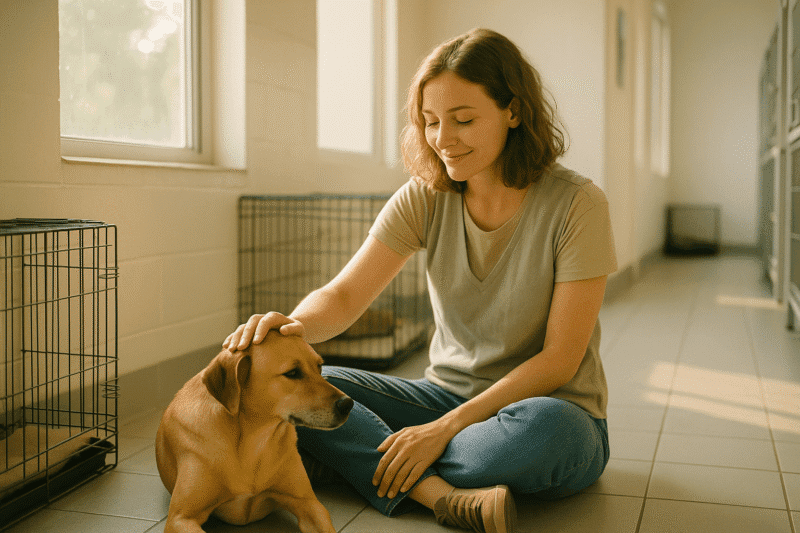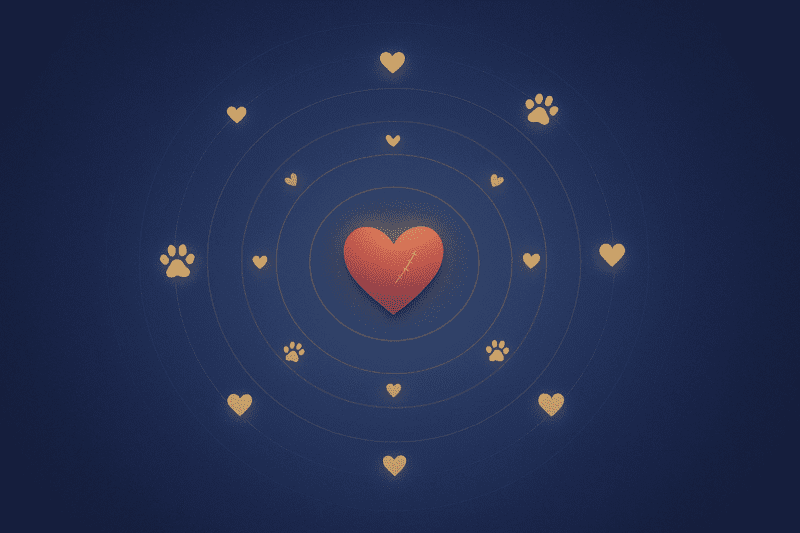This article is written for you, the one who feels deeply. Here you will find recognition, guidance, and the gentle reminder that your sensitivity is not your weakness – it is your power.
If the sight of a stray dog trembling on the roadside makes your chest ache, you are not “too sensitive.” You are one of the rare souls who still hears the silent cries of life. Witnessing animal cruelty is not something your heart can ignore, because your empathy runs deeper than most. You may often wonder: “Why do I feel so much, while others just walk by?”
This depth of feeling is not a flaw. It is a gift – the very essence that connects you to compassion and the call of helping animals. Whether or not you have ever put a name to it, you are already part of a quiet movement of animal rescuers and animal advocates who carry light into places that would otherwise remain in shadow.
And yet, this gift can feel like a heavy burden. Empaths often believe they are alone in their pain. But you are not. Every act of kindness, no matter how small, is noticed by someone – by the animal itself, sometimes by a child watching silently, sometimes by a stranger who finds the courage to act because you did first. For gentle support we highly reccomend Animal Empathy Support Meditation.

Woman in an animal shelter gently strokes a dog, reflecting everyday compassion from animal rescuers and volunteers.
Why Empathy for Animals Hurts – and Why It’s a Gift Amid Animal Cruelty?
To be deeply empathetic is both a wound and a blessing. When you see the reality of animal cruelty, you don’t just witness it from a distance – you feel it. Your body tenses, your breath shortens, and your heart absorbs the pain as if it were your own. Many people can look away. They scroll past the image, turn their head on the street, or numb themselves with distraction. But you cannot, because your heart refuses to become hardened.
This depth of sensitivity can be overwhelming. For an empath, a single story of abuse can replay in the mind for days, while others move on within minutes. To stand in front of a shivering cat abandoned in a box, or to hear the cry of a chained dog, is not just an observation – it’s a piercing experience. And yet, within this pain lies a hidden strength.
Your ability to feel so deeply is the very reason you are drawn to helping animals. It awakens an inner fire that calls you toward action, whether that means comforting a stray, supporting animal rescuers, or raising your voice as one of the countless animal advocates working for change. Your tears are not weakness. They are the proof that your heart is still alive, still open, still connected to the suffering and the beauty of life.
Empathy hurts because it dissolves the walls between “me” and “them.” It reminds us that we are all connected, that the suffering of one being ripples outward to touch us all. And while this can feel unbearable, it is also what makes compassion the most powerful force for transformation in the world.
When you embrace empathy as a gift, you begin to see it differently: not as a curse that breaks you, but as a light that guides you. Your pain becomes purpose. Your sensitivity becomes strength. And your heart becomes the very place where healing begins.
You can read more about what empathy is – Greater Good Science Center – What Is Empathy?
When Compassion Becomes Too Heavy: Compassion Fatigue in Empaths
Compassion fatigue is a silent weight many empaths and caregivers eventually carry. The concept was first described in the early 1990s by researcher Carla Joinson, who noticed that nurses and frontline workers exposed to constant suffering began to show signs of emotional depletion. Today, the same phenomenon is well recognized among animal rescuers, shelter volunteers, veterinarians, and animal advocates who face the relentless reality of animal cruelty.
Unlike burnout, which often stems from overwork, compassion fatigue arises from overexposure to pain and trauma. It is not about doing too much, but about feeling too much without space to recover. The symptoms are subtle at first, emotional exhaustion, irritability, trouble sleeping, but they can grow into a numbing of joy and a sense of hopelessness.

Dominoes symbolize how helping animals creates a positive ripple effect.
Research shows that repeated exposure to suffering can cause what psychologists call secondary traumatic stress. For empaths, this doesn’t mean their compassion vanishes, on the contrary, they continue to feel deeply. But the sheer weight of emotion can overwhelm the heart, leading to sudden frustration at indifference, heavy sadness at painful stories, or even withdrawal from those who don’t seem to understand. It is not the loss of empathy, but the overflow of it.
For empaths, “shutting down” completely is rarely possible. Their nervous system is wired to notice, absorb, and respond to suffering. This is what makes them powerful allies for animals and the vulnerable – but it is also what makes them more prone to emotional fatigue. With the right practices and gentle support, even heavy compassion can be transformed back into strength. Tools such as guided meditation and NLP (Neuro-Linguistic Programming) based techniques can offer a safe way to release emotional overload and rediscover inner resilience.
Definition: APA Dictionary of Psychology – Compassion fatigue
NLP and the Power of Reframing Pain
When life feels heavy, our mind often replays painful images on an endless loop – the abandoned dog by the roadside, the injured cat no one stopped to help, the indifference of people who walked away. For an empath, these inner pictures can become unbearable. But through the tools presented, pain doesn’t have to remain just pain, it can be reframed and transformed into a source of strength.
At its heart, NLP is about how we interpret the world through our thoughts, memories, and language. Simple techniques, like anchoring technique, help us connect a gesture or touch to a feeling of safety – for example, placing a hand on the wrist so that later the same gesture recalls calm and inner peace. Reframing allows us to look at the same memory from a new perspective; instead of seeing only the cruelty, we can also notice the compassion that rose in us – proof that our empathy is alive. And the timeline technique helps us gently revisit the past and imagine a brighter future, so that painful experiences no longer define our path, but guide us toward healing.
In the guided meditation offered by Catosophis, these principles come alive. You are invited to take the weight in your heart and imagine it as a light rising from your chest, glowing warmer and brighter until it touches the places where pain once lived. What once felt like helpless sorrow slowly becomes a symbol of connection, reminding you that your compassion itself is a healing force.
This is the quiet power of NLP techniques and hypnotic meditations; the same inner scene that once broke you can become the very image that restores you. Pain becomes light. Helplessness becomes strength. And what once isolated you becomes the bridge that connects you to others who feel just as deeply.
Find Strenght Through Animal Empathy Support Meditation: Healing Through Hypnosis
For many empaths, traditional meditation, focusing on breath or repeating a mantra , can bring temporary relief, but it often fails to reach the depth where the pain truly lives. When your heart aches from animal cruelty and your mind replays scenes of suffering, silence alone can feel insufficient. The storm inside asks for more than stillness; it asks for transformation.
This is where Animal Empathy Support Meditation makes a profound difference. Instead of leaving you alone with your thoughts, it becomes an active guide that speaks directly to both the conscious and subconscious mind. Through gentle, layered suggestions, the practice helps your inner world shift in ways that simple observation cannot. Where ordinary mindfulness may stop at awareness, hypnotic meditation goes further – it opens a door to healing at the root.
A distinctive element of the Catosophis approach is the stereo effect; the voice moves between your left and right ear, creating an immersive soundscape that engages the brain in a more dynamic way. Listeners often describe it as being “wrapped” in the meditation, as if the guidance doesn’t just reach the mind, but resonates through the whole body. This deepens relaxation, softens resistance, and makes space for new patterns to take hold.
Unlike ordinary guided sessions, this meditation does not ask you to ignore pain or push it away. Instead, it teaches you how to gently hold it, reshape it, and allow it to become something different. The heaviness in your chest softens, not because the world changed, but because your relationship to the pain transformed.
For those who carry the weight of compassion, Animal Empathy Support Meditation is more than a practice. It is a sanctuary where sensitivity is not a burden, but a strength, where sorrow becomes softer, and love becomes luminous.
The Feeling of Belonging: You Are Not Alone
One of the most difficult experiences for empaths is the belief that they are alone in how deeply they feel. When you notice animal cruelty, when you cry over a story of neglect, or when you stop to comfort a stray no one else even saw, it can feel like you live in a world that does not understand you. The truth is far gentler – You are not alone!
There are countless others who carry the same sensitivity, even if they remain quiet. Many of them are the unseen animal rescuers, the everyday animal advocates, and the silent helpers who give without recognition. Your compassion connects you to a hidden community of light-bearers – people whose hearts are touched just like yours.

Stitched red heart with concentric circles, surrounded by hearts and paw prints – empathy extending to helping animals.
Modern society often encourages disconnection. We scroll, compare, and move fast. We hide our grief because others might call it “too much.” But belonging means realizing that your sensitivity is shared. You are part of a larger circle of compassionate souls – and when you recognize this, the heaviness of empathy becomes lighter. Instead of isolation, you find connection. Instead of despair, you discover quiet strength in knowing that your empathy joins a chorus, one that is already softening the world.
Why Compassion Changes the World
For empaths, one of the deepest wounds is the awareness that no matter how much you care, you cannot rescue them all. Not every abandoned pet can be taken home, not every story of suffering can be rewritten. This truth can feel unbearable – but it does not make your compassion meaningless.
The essence of change has never been about saving everyone. It has always been about the ripple effect of one act, multiplied through others. When you comfort a single stray, you may not end global animal cruelty, but you have transformed that one life. And transformation spreads. A passerby might see your kindness and be moved to act differently next time. A child might remember your example for years and grow into one of tomorrow’s animal advocates.
Research in behavioral science confirms this ripple effect: witnessing compassionate action increases the likelihood that others will engage in prosocial behavior themselves.
This is why even the smallest gesture matters. Feeding, comforting, rescuing or simply refusing to look away – each act sends out waves that move beyond what you can see. As Mahatma Gandhi once reminded us, “The greatness of a nation and its moral progress can be judged by the way its animals are treated.” Until our collective relationship with animals shifts, we will continue to see violence mirrored in human conflicts.
You were never asked to save the whole world. You were asked to love as deeply as you can, where you are. And in that love, the world already begins to change.
For a brief look at the “ripple effect” – how kindness spreads through communities, see: Greater Good – How Kindness Spreads in a Community
FAQ: Empathy, Animal Cruelty, and Compassion Fatigue
1) Is it normal to feel overwhelmed by stories of animal cruelty?
Yes. Deep empathy means your nervous system mirrors what you witness. Overwhelm is a humane response – not a flaw.
2) What’s the difference between compassion fatigue and burnout?
Burnout = too much doing. Compassion fatigue = too much feeling for too long without recovery space. Both deserve care.
3) How do I reduce exposure without “looking away”?
Curate your inputs: mute graphic accounts, choose text-only updates, and set viewing windows. You can care while protecting your capacity.
4) Is it okay to unfollow rescue pages if they trigger me?
Absolutely. Boundaries keep you available for helping animals over the long term.
5) What are early signs I need a break?
Irritability, emotional numbness, dread opening messages, sleep issues, loss of joy. Take a gentle pause before you crash.
6) How can I help without retraumatizing myself?
Pick low-trigger actions: transport supplies, foster short term, donate, design/post adoption bios, share wins, thank animal rescuers and animal advocates.
7) What can I do right now if I feel flooded?
Three slow breaths, sip water and press play on Animal Empathy Support Meditation
8) How do I handle guilt for “not doing enough”?
Name the quiet truths: you’re one person; small consistent acts matter. Measure effort by sustainability, not by shock tolerance.
9) People say I’m “too sensitive.” What do I say?
“Sensitive is how I notice needs – and respond.” Empathy is a strength when paired with boundaries.
10) When should I seek professional support?
If symptoms persist (sleep disturbance, panic, hopelessness, intrusive images) or daily life shrinks. A trauma-informed counselor can help.
11) How can I support animal odvocates and local rescuers?
Ask what’s most useful this week (food, vet bills, transport), amplify adoptables, and celebrate every placement to counterbalance hard news.
12) How do I keep compassion from turning into despair?
Track wins (one sentence per day), work in community, rotate roles, and anchor your care in practices that refill you – Animal Empathy Support Meditation.
Conclusion: Turning Empathy Into Strength
Empathy is not a weakness – it is your greatest strength. Feeling deeply means carrying both pain and love in equal measure. And while the weight of compassion can sometimes feel overwhelming, it is also the force that drives change, connection, and healing.
If you are ready to transform heaviness into light, and sorrow into inner peace, we invite you to experience the Animal Empathy Support Meditation. It is a gentle companion on your path – helping you honor your sensitivity, release the weight of pain, and discover the strength hidden within your compassionate heart.



